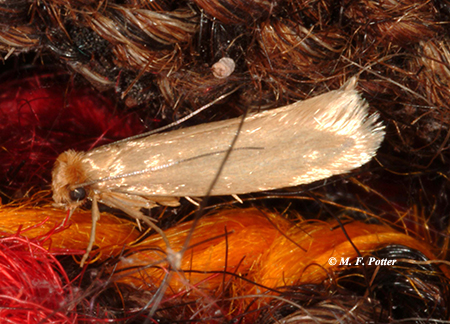Clothes Moths
ENTFACT-609: Clothes Moths | Download PDF
by Michael F. Potter, Extension Entomologist
University of Kentucky College of Agriculture
Clothes moths are pests that can destroy fabric and other materials. They feed exclusively on animal fibers, especially wool, fur, silk, feathers, felt, and leather. These materials contain keratin, a fibrous protein that the worm-like larvae of the clothes moth can digest. (In nature, the larvae feed on the nesting materials or carcasses of birds and mammals.) Cotton and synthetic fabrics such as polyester and rayon are rarely attacked unless blended with wool, or heavily soiled with food stains or body oils. Serious infestations of clothes moths can develop undetected in dwellings, causing irreparable harm to vulnerable materials.
Facts about Clothes Moths
Clothes moths are small, 1/2-inch moths that are beige or buff-colored. They have narrow wings that are fringed with small hairs. They are often mistaken for grain moths infesting stored food items in kitchens and pantries. Unlike some other types of moths, clothes moths are seldom seen because they avoid light. They prefer dark, undisturbed areas such as closets, basements and attics. Similar-looking moths spotted in kitchens and other well-lighted areas are possibly grain moths originating from cereals, dried fruit, nuts, or other stored foods.

Fig. 1: Adult webbing clothes moths (top) are sometimes mistaken for grain-infesting moths, such as the Indianmeal moth (bottom).
Two different types of clothes moths are common in North America — the webbing clothes moth (Tineola bisselliella) and the casemaking clothes moth (Tinea pellionella). Adult webbing clothes moths are a uniform, buff-color, with a small tuft of reddish hairs on top of the head. Casemaking clothes moths are similar in appearance, but have dark specks on the wings. Clothes moth adults do not feed so they cause no injury to fabrics. However, the adults lay about 40-50 pinhead-sized eggs on vulnerable substrates, which in turn, hatch into the fabric-eating larvae.
The larval stage of clothes moths are creamy-white caterpillars up to 1/2-inch long. Development time before transforming into a moth varies greatly (from one month to as much as two years), depending on temperature, food availability, and other factors. Webbing clothes moth larvae spin silken tubes or patches of webbing as they move about on the surface of infested materials. They often feed within folds of fabric and other concealed areas. As larvae graze along the surface, threadbare spots occur where fibers are removed at the base. On animal (taxidermy) mounts, clumps of hair will often detach from the skin. Also present are tiny fecal pellets.
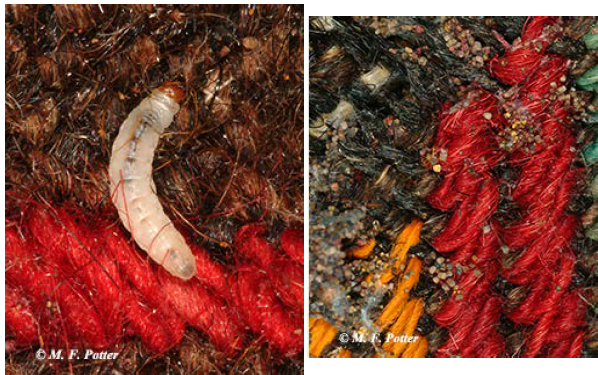
Fig. 2: Webbing clothes moth larva (left) and fecal pellets (right).
The casemaking clothes moth encloses itself in an open-ended tubular case, which it drags about wherever it goes. Incorporated into the silken case are fibers from materials the larva have fed on. Unlike the webbing clothes moth, casemaking clothes moths seldom incorporate webbing or cocoons into the materials on which they are feeding. Oftentimes, the larvae crawl off the item to spin their cocoons in crevices of shelving, or along the juncture of walls and ceilings.
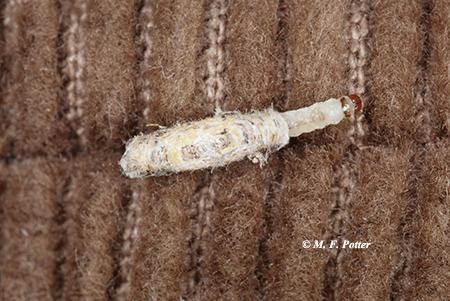
Fig. 3: Casemaking clothes moth larvae feed and move about within a tubular case.
It is important to recognize that damage attributed to clothes moths may in fact be caused by another group of insects adapted to digesting keratin— carpet beetles. Carpet beetles are very common in homes and buildings, and feed on most of the same materials as clothes moths. However, these pests are quite different in appearance. (For more information on carpet beetles, see University of Kentucky Entomology Entfact-601.) As noted earlier, clothes moths feed on such animal-derived materials as wool, fur, silk, feathers and leather. Articles commonly infested include sweaters, scarves, coats, blankets, rugs, down pillows and comforters, upholstery, toys, decorative items, and taxidermy mounts. The larvae prefer to feed in dark, undisturbed areas such as closets, chests and boxes where woolens and furs are stored for long periods. Clothing and blankets in regular use are seldom infested, nor are rugs that get a normal amount of traffic, or are routinely vacuumed. Edges and undersides of rugs, or sections beneath furniture are more likely to be attacked.
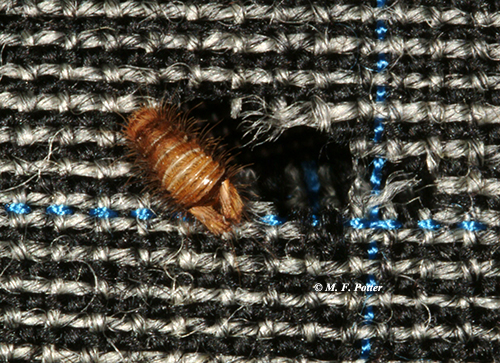
Fig. 4: Carpet beetle larvae damage many of the same materials as clothes moths.
Clothes moths may also be found infesting upholstered furniture (both inside and out), and in vents and ducts where the larvae may be feeding on lint, shed pet hair and other bits of debris. Infestations may also originate from bird nests or animal carcasses present in attics, chimneys or wall cavities.
Controlling Current Infestations
Controlling clothes moths requires a thorough inspection to locate all infested items. The primary source may be a wool scarf or fur/felt hat at the back of a closet, an old rug stored in the basement, or an abandoned bird or squirrel nest up in the attic. Larvae prefer to feed in dark, undisturbed areas where woolens and other susceptible items are stored for long periods. When inspecting clothing, pay attention to seams, folds, and creases (e.g. cuffs and collars) where larvae often prefer to feed.
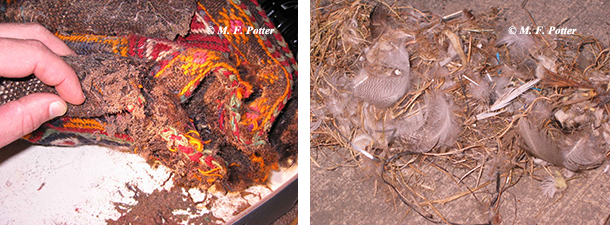
Fig. 5: A thorough inspection is needed to locate all possible sources of infestation.
Larvae also may be found along and beneath edges of rugs and carpeting. Use needle-nose pliers to lift the outer edge of wall-to-wall carpet from the tack strip along baseboards. Other possible locations include beneath/within upholstered furniture or inside heat ducts and floor vents with accumulations of pet hair and lint. Occasionally, infestations may originate from bird or animal nests in an attic, chimney, or wall cavity.
Infested items and susceptible articles nearby should be laundered, dry-cleaned or discarded. Bagging heavily infested items before disposal can help prevent further spread of the moths. Dry-cleaning or hot laundering kills any eggs or larvae that may be present. Heat generated by a clothes dryer is effective as well. Vacuuming floors, carpets, and inside heating vents effectively removes larvae as well as hair and lint, which could support future infestations. Be sure to vacuum along and beneath edges of carpets, along baseboards, underneath furniture and stored items, and inside closets and quiet areas where clothes moths (as well as carpet beetles) prefer to feed.
Insecticides applied to infested rugs and carpets may be helpful as a supplement to good housekeeping. Sprays recommended for flea control (see University of Kentucky Entomology Entfact-602), or with fabric insects listed on the label are effective. When treating, pay particular attention to carpet edges, floor/wall junctions, beneath furniture, and bottoms of closets. Infested clothing or bedding should not be treated with insecticides. Elimination of persistent infestations in homes or businesses may require the help of a professional pest control firm.
Preventing Future Infestations
Woolens and other susceptible items should be dry-cleaned or laundered before being stored for long periods. Cleaning kills any eggs or larvae that may be present, and removes perspiration odors that tend to attract pests. Articles to be stored should then be packed in tight-fitting plastic bags or containers.
Householders intending to use moth-deterring balls, flakes or crystals should carefully read and follow label directions. The volatile, odiferous products containing naphthalene or paradichlorobenzene can be hazardous if used incorrectly. Never scatter them in open closets or other areas where children or pets can reach them. The vapors from these materials are only effective if maintained at sufficient concentrations. Effective concentrations can best be achieved by sealing susceptible items (with the manufacturer’s recommended dosage of balls, flakes or crystals) in large plastic bags within in tight-fitting trunks, totes, or boxes.
Valuable garments such as furs can also be protected from clothes moths by storing them in cold vaults, a service offered by some furriers and department stores. Contrary to popular belief, cedar closets or chests are seldom effective in deterring clothes moths because the seal is insufficient to maintain lethal or repellent concentrations of the volatile oil of cedar.
Additional Tips for At-Risk Groups
Detecting Infestations. Museums, rug-dealers, craft shops, furriers and taxidermists have much at stake in preventing clothes moths. Museum artifacts, in particular, can be irreparably harmed by these pests making prevention a necessity. To minimize risk to collections, vulnerable items should be routinely monitored for signs of moth activity. Objects on display and in storage should be closely examined for holes, ‘grazed’ areas, detached hair, fur, or feathers, webbing, fecal pellets, larvae, or adult moths.
Glue traps provisioned with a pheromone lure are also useful for detecting infestations. The lure mimics the sex pheromone of the female clothes moth and is highly attractive to the males. The traps are particularly effective at revealing infestations in the early stages when the pests are hard to find by inspection alone. Pheromone ‘baited’ traps may be placed on shelves, inside closets, or wherever susceptible items occur. In large storage or display areas, the devices can be installed in a grid pattern to help pinpoint infested materials, i.e., areas where a higher number of moths are captured tend to be closer to infested materials.

Fig. 6: Pheromone ‘baited’ traps can help detect infestations.
Pheromone traps for monitoring clothes moths can be purchased online from such suppliers as Insects Limited (https://store.insectslimited.com). Since webbing and casemaking clothes moths each have their own unique pheromone odor, it is important to know which type of moth you have before ordering.
Thermal Disinfestation. Insecticide sprays tend to be of limited use for clothes moths, since the pests are often within materials where sprays cannot penetrate. Risk of contamination and staining further negates their use on museum objects, clothing, etc. Such items can often be disinfested more effectively utilizing a household, chest, or walk-in freezer. In order to kill clothes moths, infested items need to be held at minimum temperature of 0 degrees Fahrenheit for at least one week. Freezers capable of reaching minus 20 degrees F are able to kill all life stages within 72 hours. Before freezing, articles should be placed in plastic bags, or wrapped in polyethylene sheeting and sealed with tape. This prevents frost and ice from forming on objects during chilling, and condensation after removal. After freezing, objects should be allowed to return to room temperature (for about 24 hours) before being unwrapped or further handled. Some items become brittle at low temperatures, and this will help to reduce breakage. For more tips on using cold (and heat) to control pests, see University of Kentucky Entomology Entfact-640, Thermal Disinfestation of Household Items. Another good online resource for managing pests in museums and other collection-holding institutions is http://museumpests.net/.

Fig. 7: Freezing is an effective way to kill clothes moths.
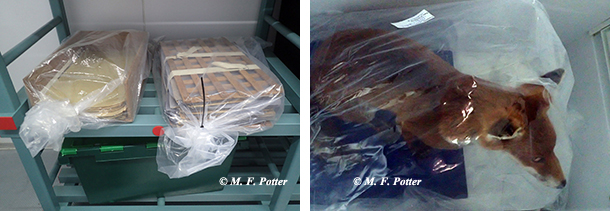
Fig. 8: Prior to freezing, items should be wrapped in plastic.
CAUTION: Some pesticides mentioned in this publication may not be legal in your area of the country. If in doubt, please consult your local cooperative extension service or regulatory agency. ALWAYS READ AND FOLLOW LABEL DIRECTIONS FOR THE PRODUCT YOU ARE USING.
Please note that content and photos in this publication are copyrighted material and may not be copied or downloaded without permission of the Department of Entomology, University of Kentucky.
